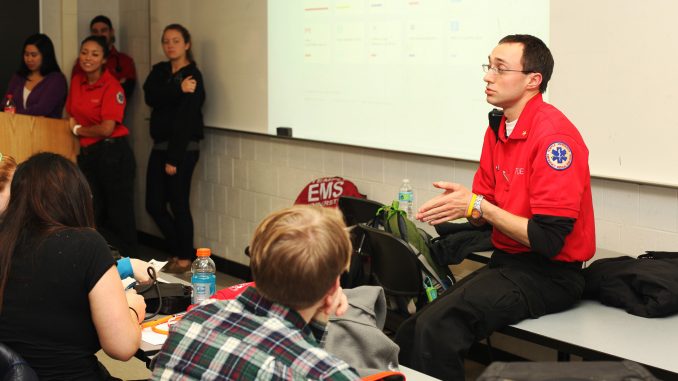
Denise Wilhelm, captain of patrol operations for Campus Safety Services, said taking part in Temple Emergency Medical Service changes her view of students.
“I think the biggest thing is that when you’re out there working with them, you don’t look at them as a student any longer,” Wilhelm said. “They’re a professional.”
The student-staffed Temple Emergency Medical Service fields two-person EMT crews every night in 4-hour shifts from 7:30 p.m. to 3 a.m. and serves the areas around Main Campus. TUEMS membership consists of about 40 students looking to gain experience in the medical field.
Executive Director of Campus Safety Services Charlie Leone said the crews mostly respond to over-intoxication, but many other TUEMS patients find themselves victims of sports injuries, falls, allergic reactions and car accidents.
A typical weekend brings an average of 14-15 calls per night. Busier weekends, like Homecoming or “Halloweekend,” usually necessitate additional staff members.
The crews are state-certified EMTs that have braved an exhaustive selection process. Besides having to take a class at a state-registered EMT facility, the responders must also receive a certification from the International Police Mountain Bike Association, 16 hours of shadowing at Temple Hospital’s Emergency Department and meet the 16-hours-per-month minimum duty requirement while taking classes.
Occasionally, they have to deal with trauma.
“I’ve seen both ends of the spectrum, where people had minor injuries and we were able to quell their fears and alternately I’ve seen people succumbing to their horrific injuries,” said Zachary Reichenbach, the founder and director of TUEMS, currently in his final year of medical school at Temple.
“I’ve learned so much in terms of management and leadership and medicine,” he added.
Reichenbach founded the program in 2006. He said he envisioned TUEMS as an “extra layer” to Temple Police’s existing emergency response plan.
“Initially I was thinking, ‘How’s this going to work?’” Leone said. “And it worked out. The relationship’s great, the officers and the EMTs work together well.”
Junior kinesiology major Eric Misthal, who serves as an education officer, conducts monthly training sessions to make sure his fellow providers maintain their skill set.
Misthal said he benefited from participation in the program.
“The experiences you have with your patients, building your bedside manner, people skills by doing evaluations, seeing how you can help them, how to make them feel better,” Misthal said. “That, I think, is the most important part for me and it’s something that I think will serve me well in the future.”
TUEMS has the resources to field up to two bike teams at a time, dispatched through Temple Police’s radio frequency. Upon arriving at the scene and ensuring that it is secure, the EMTs assess patients and provide first aid that ranges from simple bandages to something as invasive as CPR or breathing tubes.
Throughout the response process, the EMTs periodically consult with a team at Temple University Hospital commonly known as Medical Command. If the wounds are too severe to be handled by first responders, a fire rescue ambulance is called. If not, the patient must have the approval of Medical Command and sign a refusal form before he is allowed to leave.
Misthal said his first major trauma case was that of Landon Nuss, 19, who was visiting friends last September. Nuss fell down one story from a stairwell at Kardon/Atlantic apartments. He was taken to Hahnemann University Hospital where he was later pronounced dead.
“[He] hit his head open pretty well,” Mishtal said.” There was lot of blood, it took me a second to get used to it. But we did what we were supposed to, we held his head, we checked him out.”
The TUEMS team wants community members to know that they should not hesitate to call whenever the need arises.
“We’re not going to write you up,” Reichenbach said.“We’re not here to get you in trouble.”
Vsevolod Leskin can be reached at vsevolod.leskin@temple.edu


Be the first to comment